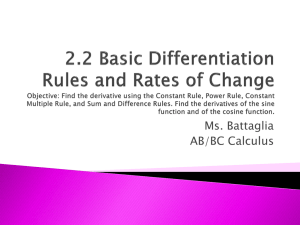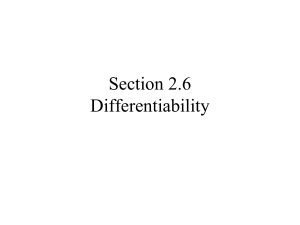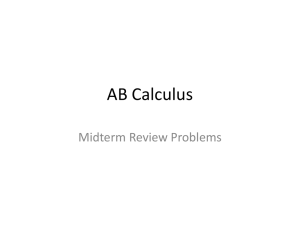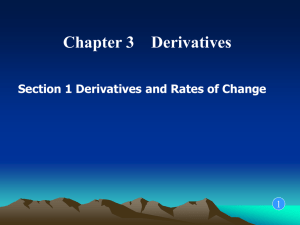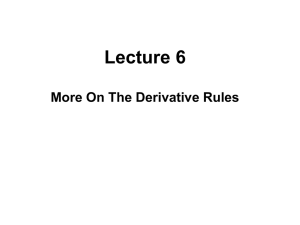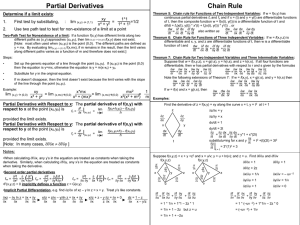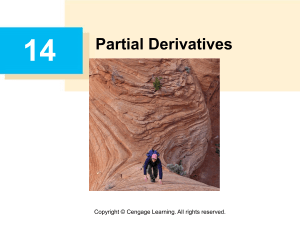x , y
advertisement
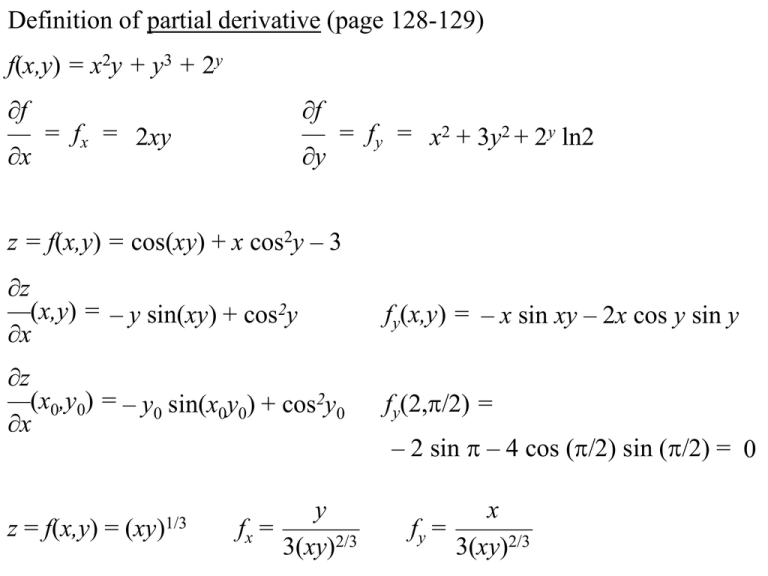
Definition of partial derivative (page 128-129) f(x,y) = x2y + y3 + 2y f — = fx = 2xy x f — = fy = x2 + 3y2 + 2y ln2 y z = f(x,y) = cos(xy) + x cos2y – 3 z —(x,y) = – y sin(xy) + cos2y x fy(x,y) = – x sin xy – 2x cos y sin y z —(x0,y0) = – y0 sin(x0y0) + cos2y0 x fy(2,p/2) = z = f(x,y) = (xy)1/3 y fx = ——— 3(xy)2/3 – 2 sin p – 4 cos (p/2) sin (p/2) = 0 x fy = ——— 3(xy)2/3 Compare the functions y = x2 and y = x2/3 in R2, and decide whether or not each function is differentiable at x = 0. Either by looking at graphs or y = x2 y y = x2/3 y from the definition of derivative, we see that y = x2 is differentiable x x at x = 0 but y = x2/3 is not. Now consider the function z = f(x,y) = (xy)1/3 in R3. z What does f(x,y) look like in the xz plane where y = 0? z = 0 What does f(x,y) look like in the yz plane where x = 0? z = 0 y x What does f(x,y) look like in the plane where x = y? z = t2/3 where t represents a variable which gives the value of x = y. Now consider the function z = f(x,y) = (xy)1/3 in R3. z What does f(x,y) look like in the xz plane where y = 0? z = 0 What does f(x,y) look like in the yz plane where x = 0? z = 0 y What does f(x,y) look like in the plane where x = y? z = t2/3 where t represents a variable which gives the value of x = y. x We find that for functions in R3, it is possible for a “level curve” in one direction to be differentiable at a point while a “level curve” in another direction is not differentiable at the same point. A function in R2 is differentiable at a point, if and only if there exists a line tangent to the function at the point. A function in R3 is differentiable at a point, if and only if there exists a plane tangent to the function at the point. In order that a function f(x,y) be differentiable at a point (x0 , y0), the function must be “smooth” in all directions, not just in the x-direction and y-direction. If a function f(x,y) is differentiable at point (x0 , y0), then we can use the value of each partial derivative at the point to find the equation of the plane tangent to the function at the point: The equation of the tangent plane can be written as g(x,y) = ax + by + c. The following must be true: g(x0 , y0) = ax0 + by0 + c = f(x0 , y0) , gx(x0 , y0) = a = fx(x0 , y0) , gy(x0 , y0) = b = fy(x0 , y0) . The equation of the tangent plane is g(x,y) = fx(x0 , y0) x + fy(x0 , y0) y + f(x0 , y0) – fx(x0 , y0) x0 – fy(x0 , y0) y0 which can be written z = f(x0 , y0) + fx(x0 , y0) (x – x0) + fy(x0 , y0) (y – y0) . Definition of differentiable and tangent plane in R3 (page 133) See the derivation on page 132. Example Find the plane tangent to the graph of z = x2 + y3 – cos(pxy) at the point (8 , –4 , –1) . f(8 , –4) = –1 f — = fx = 2x + py sin(pxy) x f — = fy = 3y2 + px sin(pxy) y fx(8 , –4) = 16 fy(8 , –4) = 48 The equation of the tangent plane is z = –1 + 16(x – 8) + 48(y + 4) which can be written 16x + 48y – z = –63 . Look again at the definition of differentiable in R3 on page 133, and observe that we can say f(x,y) is differentiable at (x0 , y0) if This is the difference between the exact function value at point (x , y) and the approximated value from the plane tangent to the function at (x0 , y0). f(x,y) – f(x0 , y0) – fx(x0 , y0) fy(x0 , y0) (x – x0) (y – y0) lim ————————————————————— = 0 ||(x , y) – (xo , y0)|| (x , y)(xo , y0) If x = (x1 , x2 , …, xn) is a vector in Rn, and f(x) is a function from Rn to R, then we define f(x) to differentiable at x0 if f(x) – f(x0) – Df(x0) (x – x0) lim ——————————— = 0 where || x – x0 || xxo Df(x0) is the 1n matrix of partial derivatives at x0 , and (x – x0) is the n1 matrix consisting of the differences between each variable and its specific value at x0 . (NOTE: A 1n matrix times an n1 matrix is the same as the dot product of two vectors. Suppose x = (x1 , x2 , …, xn) is a vector in Rn, and f(x) is a function from Rn to Rm. Then, we can write f(x) = [f1(x) , f2(x) , … , fm(x)] . We let Df(x) represent the mn matrix with row i consisting of the following partial derivatives: fi fi fi —— —— … —— . x1 x2 xn We call Df(x) the derivative (matrix) of f , and of course Df(x0) is the derivative (matrix) of f at x0 . Look at the general definition of differentiable on page 134. Example Find the derivative matrix for w = f(x,y,z) = ( x2 + xy4eyz , ln(xz+y) ) . _ _ | | | 2x + y4eyz | 4xy3eyz + xy4zeyz xy5eyz | | | | Df(x,y,z) = | | | | 1 / (xz+y) x / (xz+y) | z / (xz+y) | | | | | |_ _| Find the linear approximation at the point x0 = (1 , e , 0). x–1 w = f (x0) + Df (x0) (x – x0) = f (1 , e , 0) + Df (1 , e , 0) y – e z–0 = 2 + e4 1+ e4 e5 x–1 y–e + 1 0 1/e 1/e = z–0 (2 + e4)x – 2 – e4 + 4e3y – 4e4 + e5z 1 + e4 1 4e3 + y/e –1 + z/e = (2 + e4)x + 4e3y + e5z – 1 – 4e4 (y + z) / e Observe that since w = f(x,y,z) goes from R3 to R2, this linear approximation is really two linear approximations, one for each of the component functions. That is, Observe that since w = f(x,y,z) goes from R3 to R2, this linear approximation is really two linear approximations, one for each of the component functions. That is, The linear approximation for f1(x,y,z) = x2 + xy4eyz is w1 = (2 + e4)x + 4e3y + e5z– (1 + 4e4) . The linear approximation for f2(x,y,z) = ln(xz+y) is w2 = (1/e)y + (1/e)z . Recall that for a function f from Rn to R1, the derivative matrix is 1n. In certain situations, it will be convenient to treat this 1n matrix as a vector. See the definition of a gradient on page 136. Look at Theorem 8 on page 137. Look at Theorem 9 on page 137. Look at the chart at the top of page 138.
